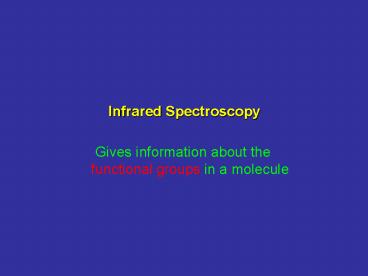Infrared Spectroscopy - PowerPoint PPT Presentation
1 / 38
Title:
Infrared Spectroscopy
Description:
Infrared Spectroscopy Gives information about the functional groups in a molecule 6 6 6 6 Molecular Weights One of the first pieces of information we try to obtain ... – PowerPoint PPT presentation
Number of Views:895
Avg rating:3.0/5.0
Title: Infrared Spectroscopy
1
Infrared Spectroscopy
- Gives information about the functional groups in
a molecule
2
Infrared Spectroscopy
- region of infrared that is most useful lies
between2.5-16 ?m (4000-625 cm-1) - depends on transitions between vibrational
energy states - stretching
- bending
3
Fig. 13.30
4
Fig. 13.31
IR Spectrum of Hexane
5
Fig. 13.32
6
Fig. 13.33
7
Fig. 13.34
8
Fig. 13.35
9
Fig. 13.36
10
Ultraviolet-Visible (UV-VIS) Spectroscopy
- Gives information about conjugated ? electron
systems
11
Transitions between electron energy states
- gaps between electron energy levels are greater
than thosebetween vibrational levels - gap corresponds to wavelengthsbetween 200 and
800 nm
?E h?
12
Conventions in UV-VIS
- X-axis is wavelength in nm
- Y axis is a measure of absorption of
electromagnetic radiation expressed as molar
absorptivity (?) - ?max is the wavelength of maximum absorption and
is related to electronic makeup of
molecule,especially ? electrons
13
UV Spectrum of cis,trans-1,3-cyclooctadiene
14
??? Transition in Alkenes
- HOMO-LUMO energy gap is affected by substituents
on double bond - as HOMO-LUMO energy difference decreases
(smaller ?E), ?max shifts to longer wavelengths
15
- Methyl groups on double bond cause ?max to shift
to longer wavelengths
H
H
H
CH3
H
CH3
H
H
?max 170 nm
?max 188 nm
16
- Extending conjugation has a larger effect on
?max shift is again to longer wavelengths
H
H
H
H
H
H
H
H
H
H
?max 170 nm
?max 217 nm
17
?max 217 nm(conjugated diene)
?max 263 nmconjugated triene plus two methyl
groups
18
Lycopene
- orange-red pigment in tomatoes
?max 505 nm
19
Mass Spectrometry
mass spec is different because it is not related
to electromagnetic radiation
20
Principles of Electron-Impact Mass Spectrometry
Atom or molecule is hit by high-energy electron
from an electron beam at 10ev
e
e beam
- forming a positively charged, odd-electron
species called the molecular ion
21
Principles of Electron-Impact Mass Spectrometry
Molecular ion passes between poles of a magnet
and is deflected by magnetic field
- deflection depends on mass-to-charge ratio
- highest m/z deflected least
- lowest m/z deflected most
22
Principles of Electron-Impact Mass Spectrometry
- If the only ion that is present is the molecular
ion, mass spectrometry provides a way to measure
the molecular weight of a compound and is often
used for this purpose. - However, the molecular ion often fragments to a
mixture of species of lower m/z.
23
Principles of Electron-Impact Mass Spectrometry
The molecular ion dissociates to a cationand a
radical.
24
Principles of Electron-Impact Mass Spectrometry
The molecular ion dissociates to a cationand a
radical.
- Usually several fragmentation pathways are
available and a mixture of ions is produced.
25
Principles of Electron-Impact Mass Spectrometry
- mixture of ions of different mass gives
separate peak for each m/z - intensity of peak proportional to percentage of
each ion of different mass in mixture - separation of peaks depends on relative mass
26
Principles of Electron-Impact Mass Spectrometry
- mixture of ions of different mass gives
separate peak for each m/z - intensity of peak proportional to percentage of
each ion of different mass - separation of peaks depends on relative mass
27
Fig. 13.39
28
Some molecules undergo very little fragmentation
- Benzene is an example. The major peak
corresponds to the molecular ion.
m/z 78
The largest peak is called the base peak and is
reference to 100 to give relative intensity.
29
Isotopesin Chlorobenzene
30
Isotopic Clustersin Chlorobenzene
- ion responsible for m/z 77 peak does not contain
Cl
31
Alkanes undergo extensive fragmentation
Decane, C10H22
The largest peak may not be the parent ion, or
may not be visible at all.
32
Propylbenzene fragments mostlyat the benzylic
position
91
120
33
Molecular Formulaas aClue to Structure
34
Molecular Weights
- One of the first pieces of information we try to
obtain when determining a molecular structure is
the molecular formula. - We can gain some information about molecular
formula from the molecular weight. - Mass spectrometry makes it relatively easy to
determine molecular weights.
35
The Nitrogen Rule
- A molecule with an odd number of nitrogens has
an odd molecular weight. - A molecule that contains only C, H, and O or
which has an even number of nitrogens has an even
molecular weight.
93
36
Exact Molecular Weights
CH3(CH2)5CH3
Heptane
Cyclopropyl acetate
C7H16
C5H8O2
Molecular formula
100
100
Molecular weight
Exact mass
100.1253
100.0524
- Mass spectrometry can measure exact masses.
- Therefore, mass spectrometry can be used to
distinguish between molecular formulas.
37
Index of Hydrogen DeficiencyDegree of
Unsaturation
- relates molecular formulas to multiple bonds and
rings
For a molecular formula, CcHhNnOoXx, the degree
of unsaturation can be calculated by
Degree ½ (2c 2 - h - x n)
38
Rings versus Multiple Bonds
Index of hydrogen deficiency tells us the sum
ofrings plus multiple bonds. Using catalytic
hydrogenation, the number ofmultiple bonds can
be determined.

